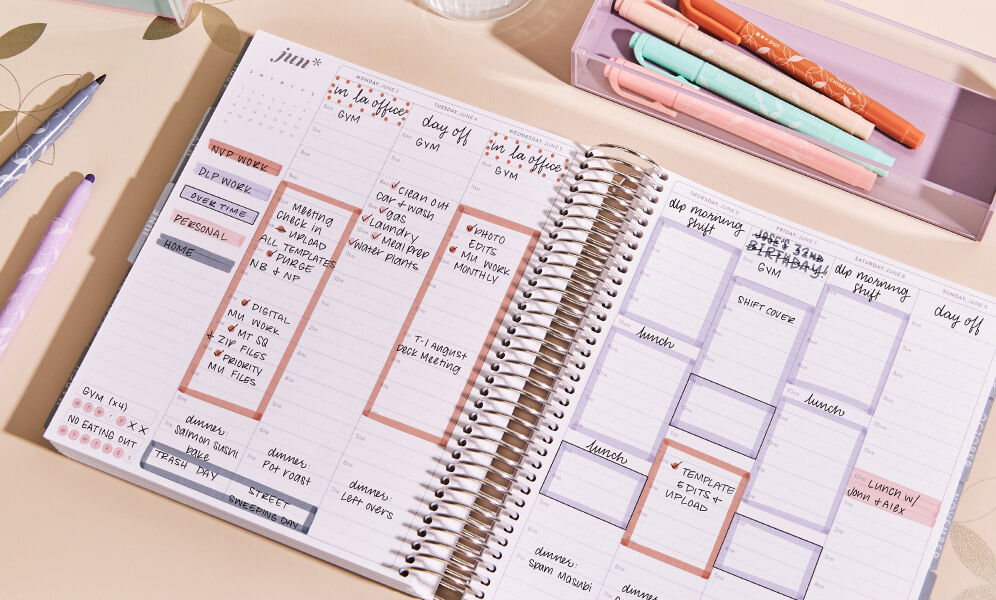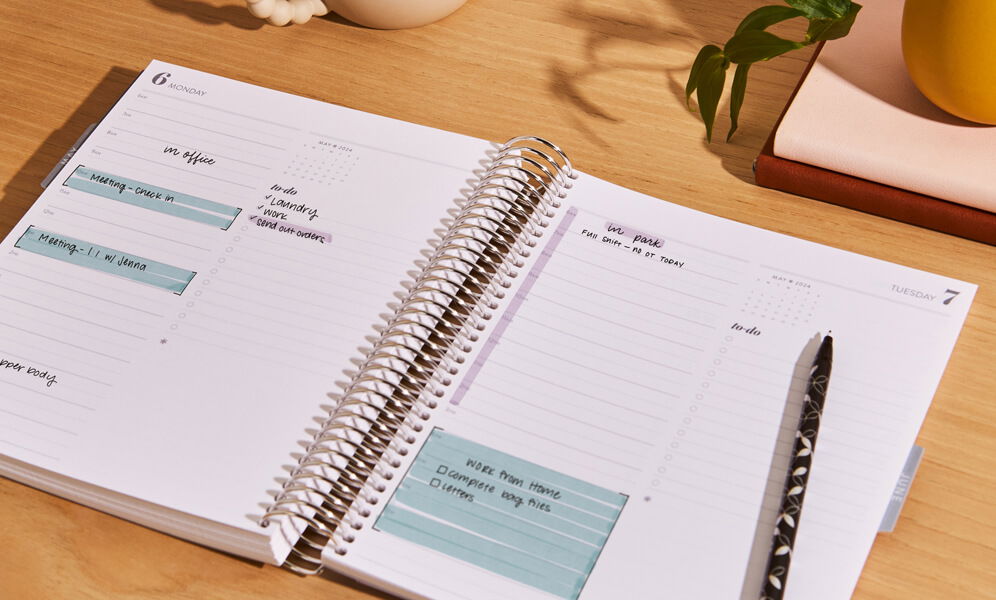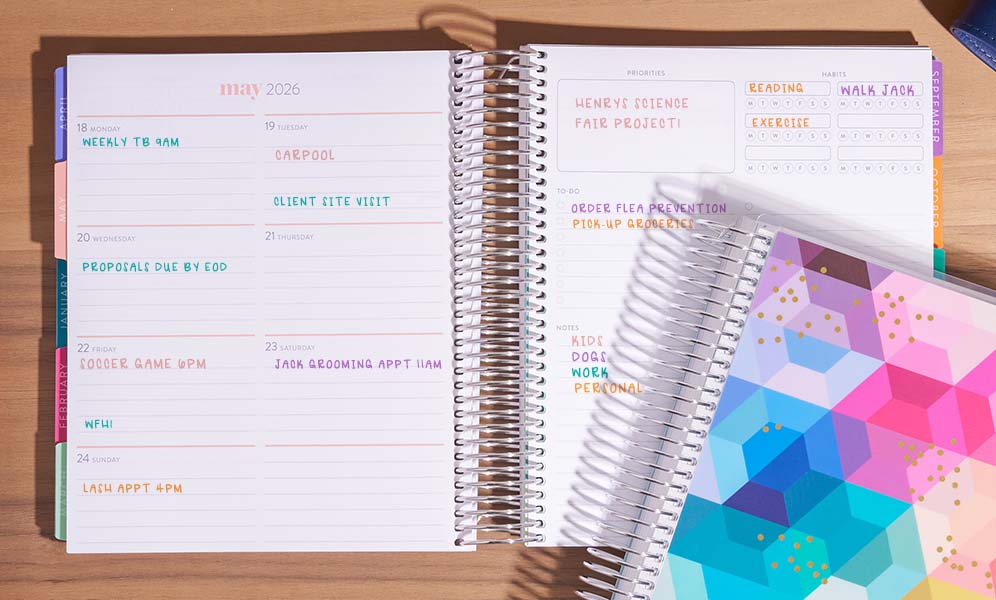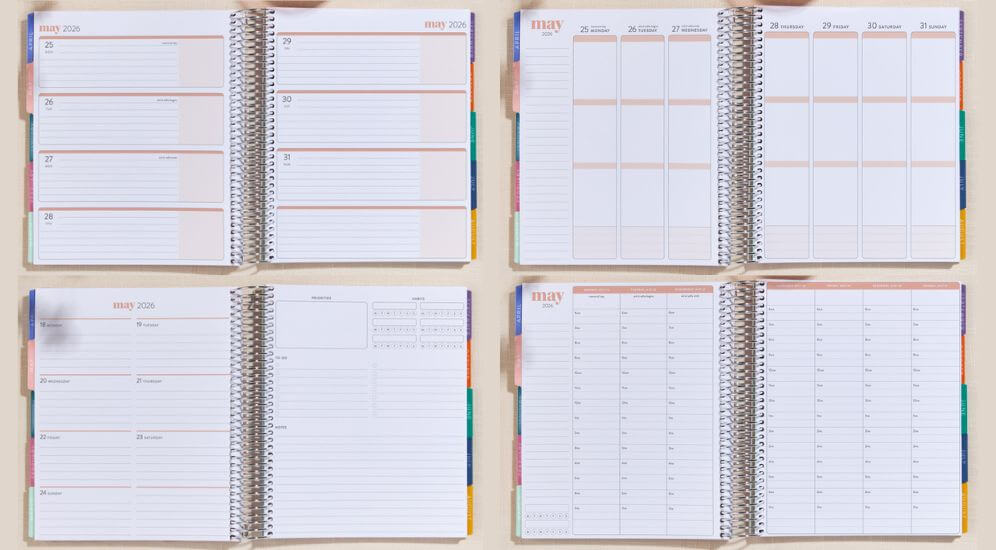7 Classic Planner Layouts + Creative Ideas for Every Lifestyle

Planners are more than just paper and ink. They are a reflection of our lives, helping us stay organized, productive, and inspired. We understand the importance of a well-designed planner, and the best planners offer a wide range of classic planner layouts that cater to every lifestyle. We'll explore seven classic planner layouts, share creative ideas to make the most of them, and help guide you in choosing the perfect planner with the perfect layout for your unique needs.
7 Classic Planner Layouts
There are seven classic planner layouts that are designed to suit various preferences and lifestyles. Whether you prefer daily, weekly, or monthly planning, each layout offers a different approach to planning, as well as different benefits, making it easy for you to find the perfect match for your organization style.
1. The Hourly Layout

The hourly layout is a lifesaver for individuals who thrive on structured, time-bound planning. It features hourly time slots, typically running from early morning to late evening. An hourly planner is excellent for those with busy work schedules or students who need to manage their class timings.
Ideas for Hourly Planning:
- Color-code your time slots to differentiate between work, personal, and leisure activities.
- Use the notes section to jot down quick reminders, important phone numbers, or inspirational quotes to keep you motivated throughout the day.
- Decorate your hourly planner with stickers and washi tape to add a touch of creativity to your day-to-day planning.
Explore How to Plan in an Hourly LifePlanner™ + 10 Creative Planner Prompts.
2. The Daily Layout

The daily layout is a go-to choice for those who prefer a page dedicated to each day. A daily planner offers ample space to detail your daily to-do list, appointments, and notes, ensuring you can focus on one day at a time.
Ideas for Daily Planning:
- Create a habit tracker to monitor your progress with daily routines like exercise, water intake, or reading.
- Add gratitude journaling to your daily routine to remind yourself of the positive aspects of life.
- Utilize ample space to reflect on your day, make notes about lessons learned, or simply jot down moments of joy.
For more daily planning ideas, check out How to Use a Daily Planner.
3. The Weekly Layout
The weekly layout strikes a balance between detailed daily planning and an overarching view of your week. A weekly planner is perfect for those who want to see their week at a glance and plan accordingly.
Ideas for Weekly Planning:
- Use the left side of the spread to outline your priorities for the week and allocate tasks to specific days.
- Incorporate a meal planning section to organize your weekly meals and grocery shopping lists.
- Customize the right side with colorful stickers, doodles, and motivational quotes to keep your weekly planning engaging and enjoyable.
Discover the pros and cons of the Daily LifePlanner™ Vs. Weekly LifePlanner™ + get planning tips and prompts for each layout.
4. The Monthly Layout

The monthly layout offers a big picture of your month. A monthly calendar, or monthly planner, is great for long-term planning, goal setting, and tracking important events, birthdays, and anniversaries.
Ideas for Monthly Planning:
- Color-code events to categorize them easily, such as work-related, social, or personal events.
- Use the monthly spread to set monthly goals, create a reading list, or plan travel itineraries.
- Employ the notes section for brainstorming, sketching, or drafting ideas that you'll tackle during the month.
For more monthly planning ideas, check out How to Use a Monthly Planner.
5. The Horizontal Layout

The horizontal layout divides each day into sections, which makes it easier to categorize your tasks and plans.
Ideas for Horizontal Planning:
- Organize your day by time blocks within each section for even more precise planning.
- Create a running to-do list along the bottom of each page for tasks that aren't tied to specific times.
- Incorporate habit tracking into the horizontal layout, dedicating a section for daily, weekly, or monthly habits.
Explore How to Plan in a Horizontal Weekly LifePlanner™ + get 10 creative planning prompts.
6. The Vertical Layout

The vertical layout is a versatile choice that allows you to create columns for different aspects of your life, making it perfect for multitaskers. Whether you're juggling work deadlines, personal errands, or wellness goals, the vertical layout provides a clear and structured format that can help you stay organized and efficient. By dividing your planner into distinct columns, you can visually separate your tasks and appointments, ensuring that nothing falls through the cracks. This layout is especially popular among those who thrive on detailed planning and appreciate the ability to customize their planner to fit their unique needs.
Ideas for Vertical Layout Planning:
- Customize each column for work, personal life, health, or any other categories that apply to your lifestyle. This allows you to see all aspects of your life at a glance, making it easier to balance your responsibilities and commitments.
- Add decorative elements to each column to give your planner a personalized touch. Using stickers, washi tape, and colorful pens can make planning more enjoyable and visually appealing, turning your planner into a creative outlet as well as a productivity tool.
- Dedicate one column to daily gratitude or reflections to keep a positive mindset. Taking a moment each day to jot down something you're grateful for or reflect on your achievements can help cultivate a more positive outlook and reduce stress.
- Experiment with different Erin Condren vertical layout ideas to find what works best for you. Whether you're tracking meals, fitness routines, or project deadlines, the flexibility of the vertical layout allows you to adapt it to your evolving needs.
- Incorporate Erin Condren planner ideas to maximize the functionality of your vertical layout. For instance, use the top section of each column for high-priority tasks, the middle for appointments, and the bottom for notes and reminders.
Learn more about how to plan in a Vertical Weekly LifePlanner™ + get vertical planning tips and prompts. Exploring various Erin Condren vertical layout ideas can inspire you to create a planner that not only keeps you organized but also brings joy to your planning routine.
7. The Dashboard Layout

The dashboard layout perfectly balances structure with flexibility by offering horizontal daily planning on one page and a full-width dashboard on the facing page. This versatile format works wonderfully for busy professionals tracking multiple projects, parents juggling family schedules, or students organizing assignments and activities. It's also an ideal solution for those with ADHD, providing clear visual organization without overwhelming detail. The daily horizontal spaces keep appointments in order, while the dashboard page becomes your command center for priorities, habits, and big-picture goals. With additional monthly calendars and note pages integrated throughout, this hybrid system adapts to your unique needs—whether you're planning a work presentation, tracking fitness goals, or coordinating family activities—all while keeping your most important priorities visible at a glance.
Ideas for Dashboard Planning:
Here are a few of our favorite Erin Condren monthly dashboard ideas that you can use to create a planner that truly reflects your personality and supports your lifestyle:
- Weekly Meal Planning: Use Monday through Sunday to note dinner plans and the dashboard to track grocery needs, meal prep tasks, and a running list of family favorites or recipes to try.
- Project Management: List Monday through Sunday action steps in the horizontal weekday sections while using the dashboard to monitor overall project milestones, deadlines, and resources needed.
- ADHD Management System: Dedicate the dashboard to listing "if/then" plans for common obstacles, visual reminders of routines, and celebration-worthy wins, while keeping Monday through Sunday appointments visible in the weekday planning areas.
- Health & Wellness Tracking: Record Monday through Sunday exercise, medication, and water intake in the daily planning sections while using the dashboard to track longer-term goals, symptom patterns, or mood tracking.
- Work/Life Balance: Use color-coding across both sections to visually separate work, personal, and family commitments from Monday through Sunday while dedicating dashboard space to self-care priorities and boundary reminders that might otherwise get overlooked.
Learn more about how to plan in a dashboard layout and get inspired by Erin Condren dashboard ideas with How to Plan in a Dashboard Life Planner. This layout not only helps you stay organized but also adds a creative flair to your planning routine.
Custom Planner Layout Ideas

If the classic layouts don't quite meet your needs, you can also customize your planner or try prompted journals, the PetitePlanner Folio System, or an A5 Ring Agenda Organizer System. Here are some planning tips for creating your own layouts:
Budget Planner
Taking control of your finances is a responsible and empowering decision. A budget planner can help you do just that. Customize your planner with sections for income tracking, expense categorization, and savings goals. Create monthly budget pages and integrate sections for tracking bills and financial milestones. With this planner, you'll be better equipped to achieve your financial goals.
Learn more about how to use a budget planner with Budget Planning 101.
Hybrid Layout
Combine elements from different classic layouts to create a hybrid that suits your unique lifestyle. For example, if you prefer the structure of the daily layout but also want a monthly overview, design a planner with daily pages and a monthly spread at the beginning of each month. This way, you can plan your days in detail while keeping an eye on the bigger picture.
Project Planner
If you're a project manager, an entrepreneur, or simply someone who juggles multiple ongoing projects, consider designing a project-specific planner. Create sections for each project with dedicated timelines, task lists, and space for project notes. This layout allows you to focus on the progress and details of individual projects without cluttering your daily or weekly pages.
Goal Setting Planner

Goal setting is a powerful tool for personal and professional growth. Design a planner that focuses on setting, tracking, and achieving your goals. Include sections for short-term and long-term goals, complete with action steps and deadlines. Visualize your goals through vision board pages and regularly review your progress.
Explore more with How to Set Goals Step by Step + discover creative ways to Create Your Own Agenda Planner.
Wellness Planner
Self-care and wellness have become increasingly important. Craft a wellness planner that puts your health front and center. Include sections for meal planning, tracking exercise routines, and journaling your mental health and mindfulness practices. Custom wellness planners are excellent for tracking your journey toward a healthier, more balanced life.
Travel Planner
For the avid traveler, a travel-specific planner is a game-changer. Design pages for itinerary planning, packing lists, and tracking travel expenses. Include a world map for marking your destinations and a space for notes on your favorite places to visit. A travel planner will not only keep you organized but also serve as a cherished travel journal.
Student Planner
Students have unique needs when it comes to planning. Create a student planner tailored to your academic requirements. Include sections for class schedules, assignment deadlines, and a dedicated study plan. Add pages for note-taking, project planning, and tracking grades. This specialized planner can be a valuable companion throughout your academic journey.
Learn more about how to How to Use a Planner for School.
How to Pick the Right Planner Layout for You

Selecting the best planner for you with the right layout is crucial for ensuring your planner becomes a powerful tool that enhances your life. Here's a guide to help you make an informed decision:
Assess Your Schedule
If you have a busy schedule with appointments and tasks throughout the day, the hourly or daily layout might be the best choice for you. For a more general overview, the weekly or monthly layout could be ideal.
Consider Your Planning Style
Are you someone who likes to write detailed to-do lists? The daily layout provides ample space for jotting down your tasks and notes. If you prefer a more visual approach, the dashboard layout with its various sections might be suitable.
Think About Customization

If you enjoy personalizing your planner with stickers, washi tapes, and other decorative elements, choose a layout that provides enough space for your creative expression. The horizontal and vertical layouts offer flexibility for customization.
Evaluate Long-Term Goals
If you have long-term goals or events to plan for, the monthly layout allows you to see the big picture. You can use it to mark important dates, birthdays, and deadlines, helping you stay organized in the long run.
Experiment and Adapt
Don't be afraid to experiment with different layouts. Your planning needs might change over time, and it's essential to adapt your planner to accommodate those changes. We offer a variety of interchangeable planner inserts, allowing you to switch between layouts seamlessly.
The perfect planner layout is one that seamlessly integrates into your life and keeps you inspired and organized. We live in a world filled with distractions and hectic schedules, a well-organized planner can be your ultimate companion. The classic planner layouts and customizable options we’ve discussed above offer a wide variety of choices to help you make the most of your planning experience. So, whether you're a minute-by-minute scheduler or a big-picture thinker, there's a planner layout that can elevate your organization game and keep your schedule on track all year long.
Start with best-selling planners that offer layout and design options for every personality and lifestyle, ensuring you can find a planner that feels like it was made just for you.
Related Planning Guides

You may also enjoy these other popular, guided planning tips, prompts, and inspiration from our experts:
- 11 Different Planner Types Explained + How to Choose
- Your Guide to Different Planner Sizes + How to Choose
- Daily 5-Minute Planner Check-Ins: 60 Planner Prompts to Inspire + Motivate Your Planning Journey
- How to Organize Your Planner
- Daily, Weekly, Monthly Planning Tips
- Best Planners for every goal, style, and schedule
- How to Use an Undated Planner + Prompts